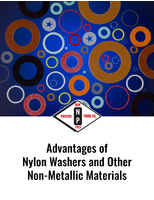Composite Materials Standard covers fatigue properties.
Press Release Summary:
ASTM D7615/D7615M, Practice for Open-Hole Fatigue Response of Polymer Matrix Composite Laminates, provides guidance for development of open-hole fatigue data for material specifications, R/D, material design allowables, and quality assurance. Standard is useful for developing design factors from relatively small standard coupons to account for effects of environmental conditions and data scatter that can then be applied to test programs involving larger scale test articles.
Original Press Release:
New ASTM Composite Materials Standard Covers Fatigue Properties of Open-Hole Composite Laminates
W. CONSHOHOCKEN, Pa.-A new ASTM International standard will answer industry's need for determination of fatigue properties of open-hole composite laminates.
ASTM D7615/D7615M, Practice for Open-Hole Fatigue Response of Polymer Matrix Composite Laminates, was developed by Subcommittee D30.05 on Structural Test Methods, part of ASTM International Committee D30 on Composite Materials.
The purpose of ASTM D7615/D7615M is to provide guidance for development of open-hole fatigue data for material specifications, research and development, material design allowables and quality assurance, according to Mark Chris, associate technical fellow, Bell Helicopter Textron Inc., and chairman of D30.05.
"The primary property that results from use of the practice is the fatigue life of the test specimen under a specific loading and environmental condition," says Chris. "Replicate tests may be used to obtain a distribution of fatigue life for specific material types, laminate stacking sequences, environments and loading conditions."
Chris also notes that ASTM D7615/D7615M is particularly useful for developing design factors from relatively small standard coupons to account for the effects of environmental conditions and data scatter that can then be applied to test programs involving larger scale test articles (from structural elements through full scale structures).
"The scale of these larger tests often makes it impractical to perform them at environmental conditions other than lab ambience," says Chris. "Also, fabricating larger test articles and performing enough test iterations to determine a statistical distribution may be cost prohibitive."
Primary users of ASTM D7615/D7615M will be engineers designing composite structures that will be subjected to cyclic loading in service, where an understanding of the fatigue response is necessary in order to design for the desired margin of safety.
Participation in the ongoing standards development activities of D30 is welcome. "We are particularly interested in any users who have experience in testing, design and analysis of composite materials that may provide additional insight or a different perspective on our standards development," says Chris.
To purchase ASTM standards, visit www.astm.org and search by the standard designation number, or contact ASTM Customer Relations (phone: 610-832-9585; service@astm.org).
ASTM International is one of the largest international standards development and delivery systems in the world. ASTM International meets the World Trade Organization (WTO) principles for the development of international standards: coherence, consensus, development dimension, effectiveness, impartiality, openness, relevance and transparency. ASTM standards are accepted and used in research and development, product testing, quality systems and commercial transactions.
View this release on the ASTM Web site at www.astmnewsroom.org.
ASTM Committee D30 Next Meeting: Oct. 17-19, 2011, in conjunction with the Society for the Advancement of Material and Process Engineering, Fort Worth, Texas
Technical Contact: Mark Chris, Bell Helicopter Textron, Inc., Dallas, Texas, Phone: 817-280-872; mchris@bellhelicopter.textron.com
ASTM Staff Contact: Ashley Wiand, Phone: 610-832-9551; awiand@astm.org
ASTM PR Contact: Barbara Schindler, Phone: 610-832-9603; bschindl@astm.org



